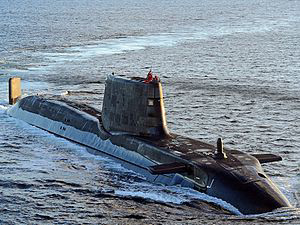Bernard Moffat, Celtic League director, writes extensively about submarine affairs in the Irish Sea and again he has expressed his concerns about the recent near sinking of the Karen, an Ardglass prawn trawler last April. He claims more evidence is mounting that Royal Navy and possibly NATO and foreign submarines are breaking agreed safety rules.
It is rumoured that a submarine came back to the Faslane base in Scotland for repairs a short time after the near sinking of the Karen, but this has not been confirmed by the Royal Navy.
[caption id="attachment_58733" align="alignright" width="300"] The HMS Ambush which snagged the net of the MFV Karen last April.[/caption]
The HMS Ambush which snagged the net of the MFV Karen last April.[/caption]
In a recent comment following the incident last April when the HMS Ambush nuclear driven, hunter killer type submarine snagged the net of the Karen 19 miles from Ardglass port, he said: “Just the day after the British Ministry of Defence indicated that one of its submarines snagged the Northern Ireland trawler MFV Karen more evidence of RN submarines failing to carry out safe operating procedure has come to light.
“The Irish Times has reported that on two occasions this year fishermen working off Tory Island, Co. Donegal, have had close encounters with submarines on the surface and in both instances the submarines failed to give way to the fishing boats.
“The Royal Navy’s own Code of Practice stipulates that a submarine on the surface should maintain a separation from an MFV and normal ‘rules of the road’ should apply. The IMO rules also place the onus on the submarine to avoid MFV’s. The RN Code also indicates that communication should be established with nearby craft so as to warn them of any likely dangers posed by the submarine operations.
“The Times article indicates no communication took place. The submarine illustrated in the article is identified by the Celtic League as an Astute Class RN nuclear hunter-killer submarine (SSN).
The area to the North and West of Donegal is used for transit by both SSN and SSBN types used by the RoyalNavy. The issue is further complicated by the fact that submarines from the Russian Federation also frequent the area hoping to pick up the tracks of RN vessels departing from their base on the Clyde. Rather embarrassingly for the United Kingdom they had to ask for external NATO assistance in tracking a suspected Russian vessel in the area last December – the UK military no longer has maritime reconnaissance aircraft.
“Meanwhile some countries take an uncompromising attitude to submarines operating in their coastal waters and the attendant dangers they pose. The Finnish Navy fired warning depth charges (low intensity explosives) at a suspected submarine in their territorial seas. Meanwhile neighbouring Sweden undertook a major anti-submarine operation after a suspected intrusion into its waters in October 2014. This year the Swedish military are to get 6 billion kroner to beef up their anti-submarine warfare capability.”
SOMETHING NASTY IN THE WATER!
[caption id="attachment_56109" align="alignleft" width="390"] The Karen docked against the wall at the quayside in Ardglass harbour.[/caption]
The Karen docked against the wall at the quayside in Ardglass harbour.[/caption]
Mr Moffat added: “Why was there a gap of several months the collision between a Royal Navy submarine and the MFV Karen and the MOD owning up?
“The most likely explanation was that the submarine was a ballistic missile of Trident Sub (SSBN) departing on patrol or one of the hunter-killer types that sometimes shadow them. Such patrols last between three and four months and during that time unless there is a dire emergency no communication with base is undertaken by either submarine under any circumstances.
“The time frame would seem to fit perfectly however if this is the case it raises two interesting scenarios.
“Firstly, with a limited deterrent fleet of four submarines, one always undergoing maintenance the SSBN will never be in a position to act in a humanitarian manner when an incident occurs during its mission.
“Secondly, if an SSBN carrying not just nuclear reactors but also 40 thermonuclear warheads can career into the nets of a small fishing boat what happens if is hits something more substantial in the relatively confined waters of the Irish Sea?
“We do unfortunately have precedence for this the USS Nathaniel Greene was so badly disabled and damaged in the South Central Irish Sea thirty years ago that it was towed back to the US and decommissioned (the admission was only made years after the event) and no one knows the extent (if any) of any pollution. In fact you could say the Nathaniel Greene was unlucky because it had Irish Sea mishaps in both 1984 and 1985.
“Sinn Fein Assembly Minister, Michelle O’Neill, has rightly voiced her anger over the MFV Karen affair. However she and other colleague politicians in Ireland, Scotland, Isle of Mann, Wales and England should not lose sight of the bigger picture.”
HMS Ambush – a Short Profile.
The HMS Ambush which caught the Karen’s net and towed it backwards, is a hunter killer class of submarine.
It can travel at 56 km.per hour under water and weighs a massive 7400 tonnes compared to the smaller 45 ton Karen. And the Ambush is roughly the length of a football pitch of 110-feet.
This submarine cam stay submerged for up to four months surfacing only for technical issues or to take on food. The Ambush is fuelled by nuclear power and will not require to be fuelled for its working life of twenty five years.
]]>























